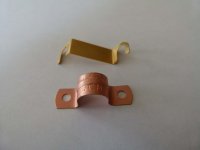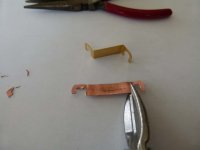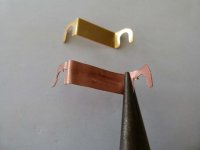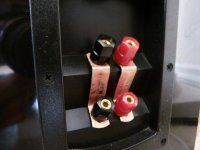If it beat the competition, then there was something VERY wrong with the competition's design. Yes simple everyday wire is good enough for not only for jumpers but most runs of speaker wire. I was being sarcastic in my post, I find fancy overpriced wire to be a waste of money.
That's the snake oil argument again. Lets not get into that in this thread.
My loudspeaker cable is just 5 metres of regular copper multicore paired cable resembling regular 5A mains cable. HF Characteristic impedance is probably about 150 ohms and quite benign.
You can model cable here: capacitane/inductance calculations
Turns out I've got a lot less than an ohm resistance and about 0.001 mH inductance per metre. I'd guess that 50 metres of that might be approaching the 0.05 mH inductance of my tweeter, so I'd expect tonal effects at that point.
General rule about cable is you should terminate it in its characteristic impedance at HF to avoid HF oscillation in the amp. Ideally your loudspeaker should have incorporated this consideration. This is not trivial, in fact, since capacitors and resistors can't be relied on to behave well at HF.
A lot of exotic and multistrand cables mess around with self and mutual inductance to produce tonal differences and change impedance, though IMO, those are mainly due to the high frequency dependence of feedback amplifiers on load and can worsen stability. The fact is it's quite difficult to make a regular twin pair or coax cable below 50 ohms characteristic impedance. It's just how the geometry works out.
Oh, FWIW, skin effect (which is the transistion of conductance to the surface of the wire strands with effects on resistance and self and mutual inductance) doesn't really occur in cables below 100Khz, so don't lose too much sleep over that. LOL
You can model cable here: capacitane/inductance calculations
Turns out I've got a lot less than an ohm resistance and about 0.001 mH inductance per metre. I'd guess that 50 metres of that might be approaching the 0.05 mH inductance of my tweeter, so I'd expect tonal effects at that point.
General rule about cable is you should terminate it in its characteristic impedance at HF to avoid HF oscillation in the amp. Ideally your loudspeaker should have incorporated this consideration. This is not trivial, in fact, since capacitors and resistors can't be relied on to behave well at HF.
A lot of exotic and multistrand cables mess around with self and mutual inductance to produce tonal differences and change impedance, though IMO, those are mainly due to the high frequency dependence of feedback amplifiers on load and can worsen stability. The fact is it's quite difficult to make a regular twin pair or coax cable below 50 ohms characteristic impedance. It's just how the geometry works out.
Oh, FWIW, skin effect (which is the transistion of conductance to the surface of the wire strands with effects on resistance and self and mutual inductance) doesn't really occur in cables below 100Khz, so don't lose too much sleep over that. LOL
Last edited:
You can spend for low capacitance and never get there.
Or use inductance to cancel it. Thats what transmission
line theory does, if your load matches the characteristic
impedance of the line.
The characteristic impedance of the line dosnt matter at audio frequencies, if effects your amp, you have a lousy amp.
For such a short run you could just buy a meter of 8mm copper tubing and flatten it or even try an old silver bracelet.
best reply so far -
has it been suggested yet to the original poster that "biwire" input terminals are often intended for either biwiring back to the amp (of course no controversy there), or (passive) bi-amping
this of course assumes no common ground in the actual XO
For such a short run you could just buy a meter of 8mm copper tubing and flatten it or even try an old silver bracelet.
Better yet, just order some copper flat bar: Order Copper 110 Rectangle in Small Quantities at OnlineMetals.com
The 12 Cent Solution
The jumpers were missing on some speakers I bought second hand. I replaced them with 1/2 inch copper pipe straps from home depot.
Flatten them out, cut the post slots, and bend them into shape. Takes about 5 minutes. A bag of 10 straps cost $1.24. So, yup, its a 12.4 cent solution.
Sounds good to me.
The jumpers were missing on some speakers I bought second hand. I replaced them with 1/2 inch copper pipe straps from home depot.
Flatten them out, cut the post slots, and bend them into shape. Takes about 5 minutes. A bag of 10 straps cost $1.24. So, yup, its a 12.4 cent solution.
Sounds good to me.
Attachments
Pure copper is about 28% more conductive than brass (obviously brass, being an alloy can have different amounts of tin in it which makes this a variable metal).
Copper bar is expensive in the UK unless you can get an offcut.
Anything made of copper can be used to fabricate some nice copper jumping straps.
Copper bar is expensive in the UK unless you can get an offcut.
Anything made of copper can be used to fabricate some nice copper jumping straps.
- Status
- This old topic is closed. If you want to reopen this topic, contact a moderator using the "Report Post" button.
- Home
- Loudspeakers
- Multi-Way
- DIY SPEAKER JUMPERS



